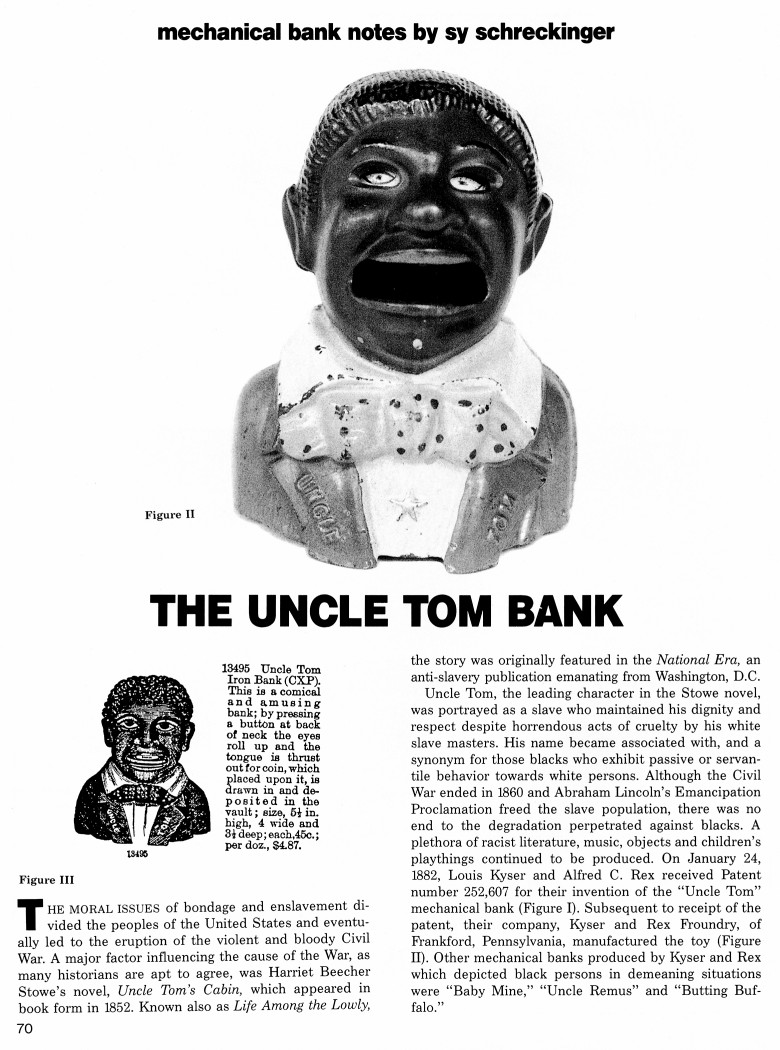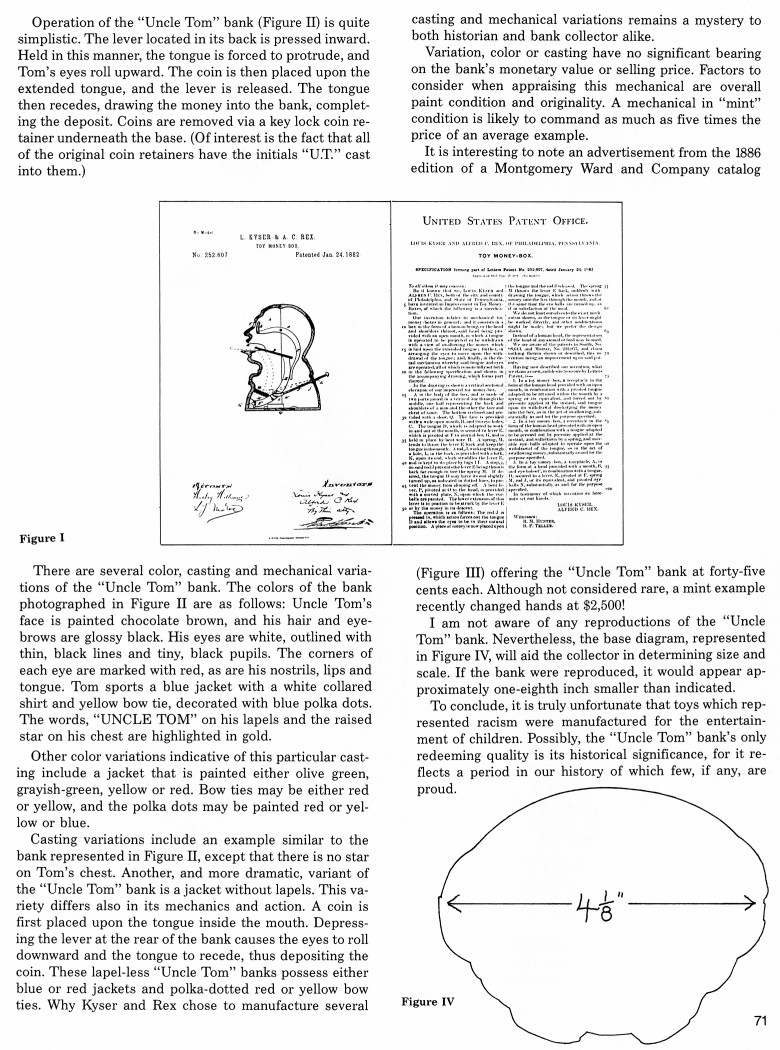|
The Uncle Tom Bank
by Sy Schreckinger – ANTIQUE TOY WORLD Magazine – August, 1990
The moral issues of bondage and enslavement
divided the peoples of the United States and eventually led to the
eruption of the violent and bloody Civil War. A major factor influencing
the cause of the War, as many historians are apt to agree, was Harriet
Beecher Stowe's novel, Uncle Tom's Cabin, which appeared in book form in
1852. Known also as Life Among the Lowly, the story was originally
featured in the National Era, an anti-slavery publication emanating from
Washington, D.C. Uncle Tom, the leading character in the Stowe novel, was
portrayed as a slave who maintained his dignity and respect despite
horrendous acts of cruelty by his white slave masters. His name became
associated with, and a synonym for those blacks who exhibit passive or servantile behavior towards white persons. Although the Civil War ended in
1860 and Abraham Lincoln's Emancipation Proclamation freed the slave
population, there was no end to the degradation perpetrated against
blacks. A plethora of racist literature, music, objects and children's
playthings continued to be produced. On January 24, 1882, Louis Kyser and
Alfred C. Rex received Patent number
252,607 for their invention of the
"Uncle Tom" mechanical bank (Figure I). Subsequent to receipt of the
patent, their company, Kyser and Rex Foundry, of Frankford, Pennsylvania,
manufactured the toy (Figure II). Other mechanical banks produced by Kyser
and Rex which depicted black persons in demeaning situations were "Baby
Mine," "Uncle Remus" and "Butting Buffalo."
Operation of the "Uncle Tom" bank (Figure II) is quite simplistic.
The lever located in its back is pressed inward. Held in this manner, the
tongue is forced to protrude, and Tom's eyes roll upward. The coin is then
placed upon the extended tongue, and the lever is released. The tongue
then recedes, drawing the money into the bank, completing the deposit.
Coins are removed via a key lock coin retainer underneath the base. (Of
interest is the fact that all of the original coin retainers have the
initials "U.T." cast into them.)
There are several color, casting and mechanical variations of the
"Uncle Tom" bank. The colors of the bank photographed in Figure II are as
follows: Uncle Tom's face is painted chocolate brown, and his hair and
eyebrows are glossy black. His eyes are white, outlined with thin, black
lines and tiny, black pupils. The corners of each eye are marked with red,
as are his nostrils, lips and tongue. Tom sports a blue jacket with a
white collared shirt and yellow bow tie, decorated with blue polka dots.
The words, "UNCLE TOM" on his lapels and the raised star on his chest are
highlighted in gold.
Other color variations indicative of this particular casting include
a jacket that is painted either olive green, grayish-green, yellow or red.
Bow ties may be either red or yellow, and the polka dots may be painted
red or yellow or blue.
Casting variations include an example similar to the bank represented
in Figure II, except that there is no star on Tom's chest. Another, and
more dramatic, variant of the "Uncle Tom" bank is a jacket without lapels.
This variety differs also in its mechanics and action. A coin is first
placed upon the tongue inside the mouth. Depressing the lever at the rear
of the bank causes the eyes to roll downward and the tongue to recede,
thus depositing the coin. These lapel-less "Uncle Tom" banks possess
either blue or red jackets and polka-dotted red or yellow bow ties. Why
Kyser and Rex chose to manufacture several casting and mechanical
variations remains a mystery to both historian and bank collector alike.
Variation, color or casting have no significant bearing on the bank's
monetary value or selling price. Factors to consider when appraising this
mechanical are overall paint condition and originality. A mechanical in
"mint" condition is likely to command as much as five times the price of
an average example.
It is interesting to note an advertisement from the 1886 edition of a
Montgomery Ward and Company catalog (Figure III) offering the "Uncle Tom"
bank at forty-five cents each. Although not considered rare, a mint
example recently changed hands at $2,500!
I am not aware of any reproductions of the "Uncle Tom" bank.
Nevertheless, the base diagram, represented in Figure IV, will aid the
collector in determining size and scale. If the bank were reproduced, it
would appear approximately one-eighth inch smaller than indicated.
To conclude, it is truly unfortunate that toys which represented
racism were manufactured for the entertainment of children. Possibly, the
"Uncle Tom" bank's only redeeming quality is its historical significance,
for it reflects a period in our history of which few, if any, are proud.
|


